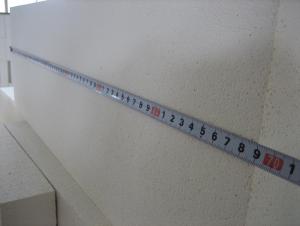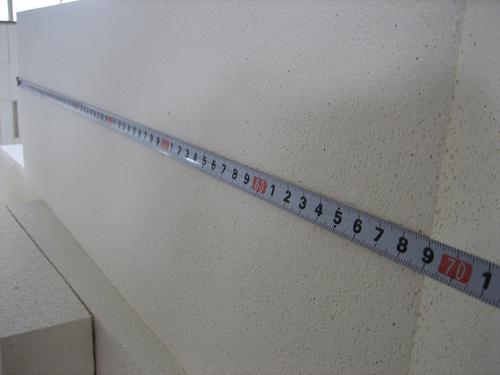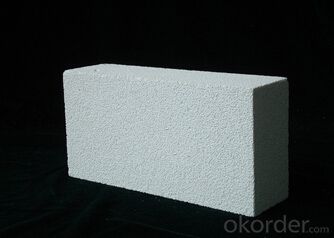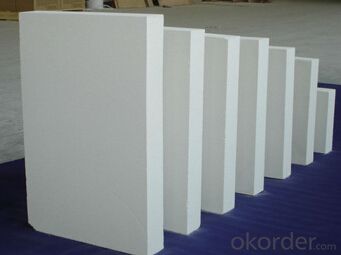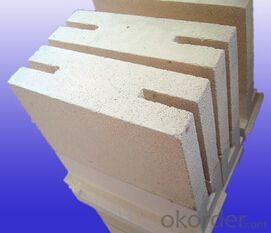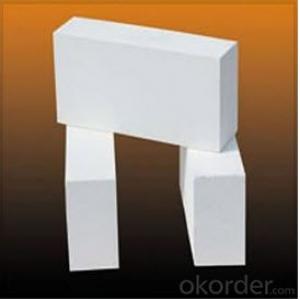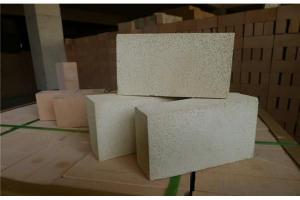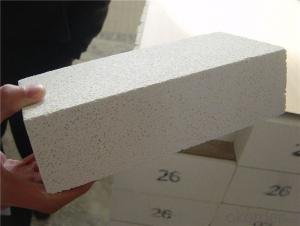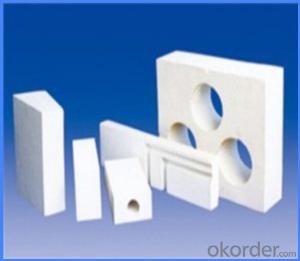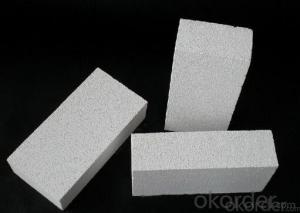Insulating Fire Brick - Mullite Jm 31 Refractory Brick
- Loading Port:
- Shanghai
- Payment Terms:
- TT OR LC
- Min Order Qty:
- 20 m.t.
- Supply Capability:
- 20 m.t./month
OKorder Service Pledge
OKorder Financial Service
You Might Also Like
General Information
CMAX insulating firebricks are classified under temperature between 1300℃ to 1700℃, manufactured from high purity alumina clay.
1. Lower content of iron, alkaline and impurities, good high temperature properties.
2. Homogeneous structure, light weight, energy saving because lower heat storage in the furnace during cooling cycles.
3. High strength, good thermal shock resistance under high temperature.
4. Precise sizes due to grinding and shaping after sintering, which meets the requirement of construction.
5. Max service temp: Up to 1730C (3160F)
Feature
Light weight and low thermal conductivity
Low heat storage
Low iron and impurities
High thermal shock resistance
Application of Insulating brick
Metallurgical Industry: blast furnace, hot blast furnace, heating furnace, etc..
Petrochemical Industry: ethylene cracking furnace, hydrogen furnace, the main furnace, heating furnace, etc..
Ceramic industry: roller kiln, kiln, etc..
Glass industry: glass furnace regenerator, etc.
Carbon industry: carbon furnace, etc..
Aluminum electrolysis industry: aluminum reduction cell, etc.
Other industries: tunnel kiln, shuttle kiln, etc.
Advantages of heat insulation brick
Low thermal conductivity: many air holes will bring good thermal insulation effect, energy saving.
High crushing strength: high crushing strength, volume stability.
Low heat storage: small heat storage, absorb more heat, energy-saving effect is obvious.
Technical Data
ITEM | GJM30 | GJM28 | GJM26 | GJM23 |
Classification Temperature, ℉/℃ | 3000/1650 | 2800/1540 | 2600/1430 | 2300/1260 |
Bulk Density,g/cm³ | ≤1.0 | ≤0.9 | ≤0.8 | ≥0.5 |
Reheating Linear Change, % | ≤0.9 (1550℃,12 h) | ≤0.8 (1510℃,12 h) | ≤0.7 (1410℃,12 h) | ≤0.5 (1230℃,12 h) |
Al2O3 Content, % | ≥75 | ≥65 | ≥55 | ≥45 |
Fe2O3 Content, % | ≤0.5 | ≤0.6 | ≤0.7 | ≤1.0 |
Thermal Conductivity: | ||||
800℃, w/m.k | ≤0.39 | ≤0.37 | ≤0.35 | ≤0.18 |
1000℃, w/m.k | ≤0.43 | ≤0.41 | ≤0.39 | ≤0.20 |
1200℃, w/m.k | ≤0.48 | ≤0.46 | ≤0.43 | --- |
Insulating brick
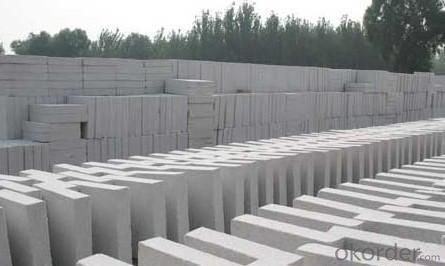
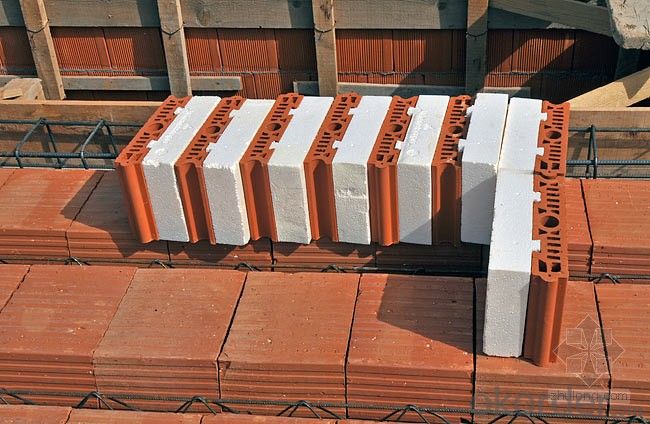
Common problem solution
1. What products do you have?
We have all kinds of refractory bricks, refractory casting materials, mortar, cement, ceramic fiber products, etc..
Or you can browse our products to choose what you need.
2. How to control product quality?
With strict quality control system throughout the material selection and production process, we have the quality of refractory materials and ceramic fiber products to meet customer requirements.
From the selection of raw materials, the quality of our control to start. The quality of the raw materials required for each batch of products in the use of the front line test. In the production process, through the quality control of workers, and then to each piece of classification, and through quality supervision and inspection.
3. Could you give me a brief introduction to the application of your product?
My Company is mainly engaged in steel, cement, glass, ceramics, petrochemical, electric power and other industries.
4. If I need you, what kind of information do you need?
In order to select the right products, we will provide us with information, such as the United States, technical data, order quantity, product applications, etc..
If you have any questions, please contact us.
- Q: What are the safety precautions when working with insulating fire bricks?
- When working with insulating fire bricks, it is important to follow several safety precautions to ensure the well-being of yourself and others. Here are some key safety measures to consider: 1. Personal protective equipment (PPE): Wear appropriate PPE, including heat-resistant gloves, long-sleeved clothing, safety goggles, and a respiratory mask. These will protect you from potential burns, cuts, and inhalation of harmful dust or fumes. 2. Proper ventilation: Work in a well-ventilated area or use local exhaust ventilation to minimize exposure to dust and fumes that may be released during handling or cutting of the bricks. 3. Fire prevention: Keep a fire extinguisher nearby and ensure the workspace is clear of flammable materials. Insulating fire bricks are highly refractory and can withstand high temperatures, but it is still important to prevent accidental fires. 4. Manual handling: Insulating fire bricks can be heavy, so use proper lifting techniques and avoid overexertion to prevent strains or injuries. If necessary, use mechanical aids such as trolleys or lifting equipment to move the bricks. 5. Cutting and grinding: When cutting or grinding the bricks, use appropriate tools and ensure they are in good working condition. This will minimize the risk of accidents or injuries. Be cautious of sharp edges and wear protective gloves to avoid cuts. 6. Temperature control: Insulating fire bricks are designed to withstand high temperatures, but avoid direct contact with hot surfaces. Use appropriate tools or equipment to handle the bricks when they are at an elevated temperature. 7. Storage and handling: Store the bricks in a cool, dry place away from direct sunlight or extreme temperatures. Avoid stacking them too high to prevent the risk of collapse or toppling. 8. Training and knowledge: Ensure you have received proper training and are familiar with the characteristics and properties of insulating fire bricks. Understand their limitations and follow the manufacturer's guidelines for safe handling and usage. By adhering to these safety precautions, you can significantly reduce the risk of accidents, injuries, and health hazards when working with insulating fire bricks. Remember, safety should always be a top priority in any workplace.
- Q: Are insulating fire bricks porous?
- Yes, insulating fire bricks are porous. Porosity is a characteristic of insulating fire bricks that allows them to have low thermal conductivity. These bricks are made from ceramic materials and contain a high percentage of tiny air pockets or voids, which trap and slow down the transfer of heat. This porosity also makes the bricks lightweight and resistant to thermal shock. The ability of the insulating fire bricks to retain heat and provide effective insulation is directly linked to their porous structure.
- Q: Are insulating fire bricks resistant to hydrofluoric acid?
- Yes, insulating fire bricks are resistant to hydrofluoric acid.
- Q: Can insulating fire bricks be used in the construction of tundishes?
- Yes, insulating fire bricks can be used in the construction of tundishes. Insulating fire bricks are lightweight and have excellent thermal insulation properties, making them ideal for applications where heat retention is important. Tundishes, which are used in the steel industry to control the flow of molten metal, require materials that can withstand high temperatures and minimize heat loss. Insulating fire bricks can withstand the extreme temperatures found in tundishes, helping to maintain the desired temperature of the molten metal and preventing heat loss. Additionally, their lightweight nature makes them easier to handle and install in tundish construction. Overall, insulating fire bricks are a suitable choice for the construction of tundishes due to their thermal insulation properties and ability to withstand high temperatures.
- Q: What is the typical flexural strength of an insulating fire brick?
- The flexural strength of insulating fire bricks can vary based on the specific composition and manufacturing process. On average, these bricks have a flexural strength ranging from 2 to 10 MPa. It should be noted that individual bricks may have slightly different flexural strengths. Insulating fire bricks are utilized for thermal insulation in high-temperature situations such as furnaces, kilns, and fireplaces. Their low thermal conductivity allows them to effectively retain heat, which is crucial in environments where temperature control is important. Flexural strength refers to a material's ability to resist deformation or breakage when subjected to bending or flexing forces. The higher the flexural strength, the more resistant the material is to bending or flexing. Typically, insulating fire bricks are made from a combination of lightweight aggregates, high-temperature binders, and other additives. This composition gives them their low thermal conductivity and insulating properties, but it also impacts their mechanical strength, including the flexural strength. It's important to note that while insulating fire bricks have relatively low flexural strength compared to other refractory materials, they are not typically exposed to significant bending or flexing forces in their intended applications. Instead, their primary purpose is to provide thermal insulation, endure high temperatures, and resist thermal shock. To summarize, the flexural strength of insulating fire bricks typically ranges from 2 to 10 MPa, but this can vary based on the specific composition and manufacturing process. These bricks are primarily designed for thermal insulation rather than high mechanical strength, and their low thermal conductivity makes them suitable for a variety of high-temperature applications.
- Q: Can insulating fire bricks be used for insulation in chemical reactors?
- Insulation in chemical reactors can be achieved by utilizing insulating fire bricks. These bricks, made from lightweight materials like vermiculite or perlite, possess exceptional thermal insulation properties. They are specifically designed to endure high temperatures and can be applied in various scenarios, including chemical reactors. Chemical reactors often operate at heightened temperatures, making it crucial to maintain a stable temperature for efficient and safe functioning. By employing insulating fire bricks as insulation in chemical reactors, the loss of heat can be minimized, resulting in increased energy efficiency and cost savings. Furthermore, these bricks aid in reducing temperature variations within the reactor, ensuring even distribution of heat and enhancing overall performance. Moreover, insulating fire bricks exhibit resistance to chemical deterioration, enabling them to withstand the corrosive impact of different chemicals employed in chemical reactions. This quality makes them suitable for usage in chemical reactors frequently exposed to corrosive substances. To summarize, insulating fire bricks offer an exceptional choice for insulation in chemical reactors. They provide outstanding thermal insulation, endure high temperatures, and possess resistance to chemical attack. By utilizing insulating fire bricks in chemical reactors, improved energy efficiency, temperature stability, and overall reactor performance can be achieved.
- Q: Are insulating fire bricks suitable for use in ceramic fiber modules?
- No, insulating fire bricks are not suitable for use in ceramic fiber modules. Insulating fire bricks are made from a different material than ceramic fiber modules and have different properties. Insulating fire bricks are typically made from dense refractory materials, such as clay or alumina, and are used for their high thermal insulation properties. On the other hand, ceramic fiber modules are made from lightweight ceramic fibers and are designed for high-temperature insulation and heat containment. They have a high resistance to thermal shock and are able to withstand rapid temperature changes. Using insulating fire bricks in ceramic fiber modules would not provide the same level of insulation and heat containment as using ceramic fiber modules. It could lead to poor performance and reduced efficiency in high-temperature applications. Therefore, it is important to use the appropriate materials for specific applications to ensure optimal performance and safety.
- Q: Do insulating fire bricks emit any toxic fumes when heated?
- No, insulating fire bricks do not emit any toxic fumes when heated. They are designed to withstand high temperatures without releasing any harmful gases or substances.
- Q: Are insulating fire bricks resistant to carbon monoxide?
- Yes, insulating fire bricks are resistant to carbon monoxide. These bricks are specifically designed to withstand high temperatures and are commonly used in applications where exposure to intense heat and chemicals, such as carbon monoxide, is expected. The insulating properties of these bricks make them highly resistant to heat transfer, allowing them to maintain their structural integrity in the presence of carbon monoxide and other combustion gases. This resistance to carbon monoxide makes insulating fire bricks an ideal choice for applications such as furnaces, kilns, and other high-temperature environments where the risk of carbon monoxide exposure is present.
- Q: Can insulating fire bricks be used for insulation in steam pipes?
- Yes, insulating fire bricks are a suitable option for insulation in steam pipes. These bricks are specifically designed to withstand high temperatures and provide excellent thermal insulation. They have low thermal conductivity, which means they prevent the transfer of heat effectively. This property makes them ideal for insulating steam pipes, as it helps to minimize heat loss and maintain the temperature of the steam inside the pipes. Additionally, insulating fire bricks are lightweight and easy to install, making them a convenient choice for insulating steam pipes.
Send your message to us
Insulating Fire Brick - Mullite Jm 31 Refractory Brick
- Loading Port:
- Shanghai
- Payment Terms:
- TT OR LC
- Min Order Qty:
- 20 m.t.
- Supply Capability:
- 20 m.t./month
OKorder Service Pledge
OKorder Financial Service
Similar products
Hot products
Hot Searches
Related keywords
